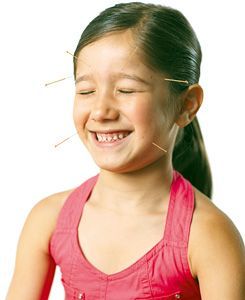Whether you accept it, avoid it or live somewhere in between, insurance coverage has become a defining issue for our profession. Patients increasingly expect to use their benefits, practitioners want to be compensated fairly for their time and expertise, and the system itself remains – at best – fragmented. The encouraging news is that coverage has expanded in meaningful ways. The challenging news is that reimbursement, across the board, remains inadequate.
Preparing Your Practice for Pediatric Acupuncture
Kids love acupuncture. I swear its true! Right now pediatric acupuncture is gaining momentum as many parents realize that acupuncture is a natural, safe and effective treatment not only for themselves, but for their children too.
According to the 2007 National Health Interview Survey (NHIS), acupuncture users increased by 1 million people from 2002 to 2007 and in 2006 approximately 3.1 million adults and 150,000 children used acupuncture. In addition, the 2007 NHIS found that children were five times more likely to use CAM therapies if their parents used them.1
I view this trend as an opportunity for the acupuncture and Oriental medicine community to enlighten an entire generation of kids to the benefits of acupuncture. An increasing number of children are growing up with acupuncture as a routine part of their healthcare, which will be instrumental in making acupuncture the treatment of choice at the onset of pain or illness instead of a treatment of last resort.
Recent studies have linked the decrease in many childhood illnesses such as ADHD and colick to the use of acupuncture. Doctors at Rush University Medical Center in Chicago have also pointed out that acupuncture is in fact effective for pain and nausea in children suffering from serios chronic illnesses.

The benefits to treating children in your practice go above and beyond simply helping a child. Helping children is highly rewarding on its own, but being a part of treating a child with an illness such as asthma can be a life changing experience for you and them. Asthma and other chronic illnesses account for countless hospital visits and missed days of school -- not to mention sports and other social activities they are unable to participate in due to illness. Restoring the health of a chronically ill child gives a new dimension and richness to their life that they may have never had before.
Many of us took a few pediatric classes and internships during our Master's program, but making a successful transition into pediatrics in private practice may take some time and a little extra training. It may even seem a little daunting at first, but as you gain more experience and confidence it will become second nature. I've outlined a few steps you can take to prepare yourself and your office for little patients.
Assess Your Office
The first place to start is an assessment of your office. Is it kid-friendly? Is your front desk staff comfortable with children? It is important to make sure that your office is relatively baby proof, that your decor is not dangerous. You must make sure hazards like electrical outlets are covered. Have a small basket of toys available, books to read and crayons and paper in the lobby area. At the end of the treatment stickers or hand stamps can provide a perfect reward for cooperative behavior during treatment.
The paperwork you have for adults may not give you all the vital information you need for kids. I recommend that you have pediatric paperwork for children under the age of 14, which asks questions about the mother's pregnancy, labor and delivery, vaccination status, and more child specific questions about appetite, digestion, energy, immune function, growth, etc. You must also have the parents sign paperwork giving their consent to treat a minor.
Be Open
Being flexible is extremely beneficial when it comes to the treatment of children. Many kids tolerate acupuncture well, but some will be resistant to anything having to do with needles. In the beginning, it is more important to build rapport with the child than to force needles upon them. Given time, trust and plenty of encouragement most children will eventually try acupuncture. In the meantime, microcurrent therapy, cold laser therapy and shonishin will produce a similar therapeutic effect as the needles. Make sure parents are informed that these other modalities will require their child to hold still while the selected device is placed on the acupuncture point for 15 - 60 seconds.
Children aren't just little people. They suffer from a variety of qi imbalances and infectious illnesses that don't normally affect adults. Because of this, additional training is absolutely vital to effectively treat the wider variety of illnesses you will encounter. Physical exam skills are also critically important since babies and children cannot always communicate why they're sick.
You'll need to look in ears and listen to lungs to properly diagnose and treat what is wrong. If these skills are rusty, I recommend taking additional courses like Pediatric Physical Exams, Diagnosis and Red Flags which is offered by the Holistic Pediatrics Association www.healthychild.com/store/brands/Holistic-Pediatric-Training.html.
You may also want to take additional classes to learn how to effectively treat some of the most common pediatric problems like asthma, allergies, ADD/ADHD, acute otitis media (ear infections), and digestive problems. Knowing what you can and cannot treat with acupuncture and when to refer to a medical doctor is essential, but with extra training you'll have the confidence you need to make the correct diagnosis and refer out as appropriate.
Most importantly you must love kids to be successful in pediatrics! Working with kids can be rewarding, challenging and at times frustrating, but when your energy reflects your desire to help them heal many of these challenges can be overcome.
References
- Barnes, Patricia. National Center for Health Statistics. 2 April 2011. National Center for Complimentary and Alternative Medicine, National Institute of Health. 10 Dec. 2008 www.cdc.gov/nchs/data/nhsr/nhsr012.pdf


